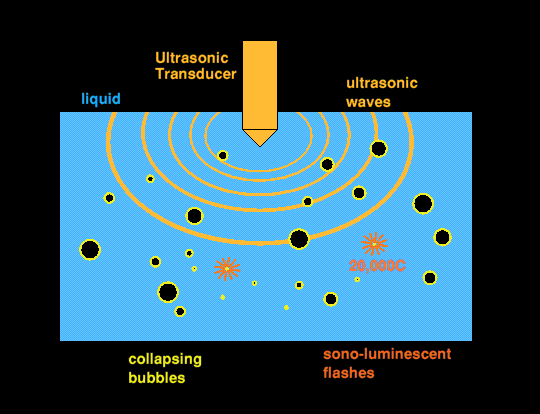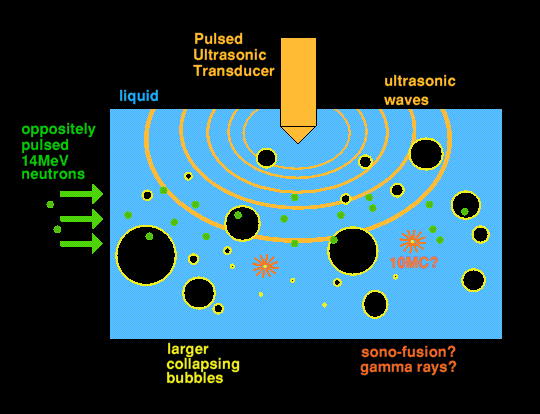
Sono-Luminescence

An ultrasonic transducer is placed in a liquid containing deuterium, some researchers used deuterated acetone, and a high-level ultrasonic signal is used to drive the transducer. This produces high-intensity acoustic sound pressure waves that travel through the liquid with an intensity sufficient that, in the low-pressure regions of the ultrasonic wave the pressure is so low that the liquid boils at well below its normal-pressure boiling-point creating micro-bubbles just 30 micrometres or so across. This process is called acoustic cavitation, and is a well-known phenomenon. This process can be used to clean small instruments. Cavitation also gives rise to the pitting of ships propellers as they spin under-water, a condition ship propeller designers strive to eliminate or at least reduce. Cavitation is responsible for tea-kettle noise and is is normally a nucleation process, where small pre-existent bubbles or impurities can drastically reduce the amount of negative pressure required before cavitation occurs, but impurities are not essential. Acoustic cavitation can also perform some amazing chemistry.
The micro-bubble, which contains small amounts of the surrounding liquid in vapour form at much reduced pressure, at first grows, but then it starts to collapse at ultra-sonic speeds in an extremely forceful implosion, compressing the vapour to a very high pressure in a very short time. This is adiabatic compression, and the vapour attains extremely high temperatures, un-able to dissipate the heat to the surrounding fluid in the extremely short time available. The micro-bubbles, which started at 30 micrometres across, are shrunk to just 60 nanometres. It has been calculated that temperatures up to 5,000 Celsius can be reached with pressures up to 1000 atmospheres. At this temperature, the molecules would totally dissociate into their individual atoms; a plasma. The plasma then emits light, this process is called sono-luminescence. The collapsing bubbles emit pin-point flashes of light. This is where the un-usual chemistry can take place, creating substances that are almost impossible to synthesize otherwise, or in extremely high yields un-achievable by other means. The chemistry available depends upon the constituents of the original liquid. This un-conventional method of chemical synthesis is making enormous progress and has enormous potential for creating novel molecules which may one day be of great value. this method of synthesis is called sono-chemistry and is capable of enhancing chemical reaction rates up to a million-fold.

But some nuclear physicists claim that the collapsing bubble creates temperatures and pressures sufficient for nuclear fusion to occur involving the deuterium. But fusion between deuterium atoms would require temperatures perhaps 2000 times higher than 5,000 Celsius and pressures upwards of 109 atmospheres! Many nuclear scientists think that such temperatures and pressures are un-attainable in sono-luminescence, especially since at 5,000 Celsius the chemical reactions themselves would soak up a lot of the energy available, limiting the attainable temperature and pressures. The researchers claim to have measured the gamma rays emitted by the fusion between deuterium atoms, and to have detected the tritium and the neutrons that would be produced should fusion be occurring. But the researchers are also bombarding the liquid with pulsed neutrons of 14MeV energy, which gives rise to bubbles that they say grow very much larger than those in sono-luminescence where there is no in-flux of neutrons. They say the bubbles grow up to 100,000 times larger than those in sono-luminescence, giving rise to much higher temperatures and pressures when the bubbles collapse. The neutrons released by fusion, it is claimed, occur when the incident neutron beam has been switched off, so are distinguishable from those that are incident. The emitted neutrons have a claimed energy of 2.5MeV or below, consistent with nuclear fusion, and were not observed in a control experiment using un-deuterated acetone. [Deuterium-deuterium fusion reactions can produce either helium-3 and a neutron, or hydrogen-3 and a proton]. Unfortunately for the researchers, the reported flux of emitted neutrons is an order of magnitude lower that that expected by the reported tritium yield!
Other researchers are quick to point out that thermo-nuclear sono-fusion may not be impossible, but it is as yet still un-proven. Many are very sceptical it is possible at all.
In the year 2005 another group of researchers have found that bombarding sulphuric acid with ultrasound produced the most intense sono-luminescence ever recorded, bright enough to measure the spectrum of the light from the collapsing bubbles themselves. They reported seeing light of the characteristic spectrum of positively charged oxygen ions, which can only form in a plasma reaching 200,000 Celsius.
![]()
![]()